21 December 2005
Court decides Saemangeum reclamation can continue
In a hugely disappointing ruling, the Seoul High Court has decided today (the 21st) that the the government can resume the Saemangeum reclamation, which according to one media report is "designed to transform large tidal flats off the country's southwestern coast into farmlands and a freshwater reservoir" (http://times.hankooki.com/).
No mention is made of the international importance of the area as a staging area for over 400,000 shorebirds annually, or the catastrophic effect this decision will have on threatened shorebird species along the East Asian/Australasian Flyway.
December 2005
Nonviolent Factors Found in the Recent “Samboilbae” Movement
An online paper by Jang Jaehyun looking at the non-violent responses to the Saemangeum Reclamation. Some of the quotations included in the paper are sourced from Birds Korea. Go to www.nonviolence.or.kr/Epapers/Samboilbae.doc.
21 October 2005
Saemangeum article in WWF-Arctic.
An article on Saemangeum, written by Nial Moores, has been published in the 03/05 issue of WWF International Arctic Programme's "Arctic Bulletin". The article looks in particular at the impact of the reclamation on Arctic-breeding shorebirds such as the Spoon-billed Sandpiper. The whole issue is downloadable as a pdf from http://assets.panda.org/downloads/ab0305.pdf.
24 August 2005
Adult Spoon-billed Sandpiper on Dongjin Estuary, Saemangeum
Highlight of a trip to Dongjin made by Claus Nielsen was an adult Spoon-billed Sandpiper. Other records of note include 100 Broad-billed Sandpipers and 400 Terek Sandpipers.
20 August 2005
13 Spoon-billed Sandpipers at Saemangeum
Highlight of a trip to Saemangeum to survey shorebirds made by Torsten Ryslavy and Peter Nebel was the discovery of up to 13 Spoon-billed Sandpiper on the Dongjin Estuary. We will of course post more details when we recieve them.
16 and 17 August 2005
New Zealand shorebird specialist visits Saemangeum
As part of our ongoing work to both internationalise the campaign against the Saemangeum reclamation and pass data and information to overseas experts, Birds Korea was delighted to organise and host a visit by renowned New Zealand shorebird specialist Adrian Riegen of the New Zealand AWSG and Miranda Trust.
In very high temperatures (ca 32 C max) and with only neap tides, a two-day study tour of the Saemangeum estuarine area still produced well over 20 000 shorebirds comprising 30 species in those areas visited, with most numerous being Great Knot (ca 15 000), Black-tailed Godwit (ca 4 500, with possibly a further 2 000+ on the Geum) and Terek Sandpiper (ca 1400). Observations also included a Nordmann's Greenshank and seven leg-flagged Red Knot (one of which was probably flagged by Adrian himself back in NZ).
The trip went extremely well, and we are sure that the links made here will be very valuable in the future.
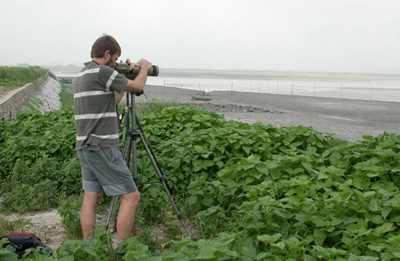 Adrian Riegen, New Zealand shorebird specialist, Saemangeum © Nial Moores
Adrian Riegen, New Zealand shorebird specialist, Saemangeum © Nial Moores01 July 2005
Saemangeum and the Hawaiian Connection!
On June 29th and 30th, 20 hand-picked high-school students and three educators from Hawaii visited Saemangeum, as part of a cultural tour to South Korea organised by the Pacific and Asian Affairs Council.
The highly-threatened yet still inspirational Saemangeum area was chosen for the "PAAC tour" as it so obviously represents the very best (and very worst) of Korea...
Nial Moores and Park Meena of Birds Korea, joined by leading independent activist Chu Yong-Gi, guided the group to the tidal-flats of the Dongjin River, followed by a meeting with local fisher and community leader Yeom Joeng-oo, and a visit to a local high-school.
Over the two days, many great ideas for challenging the reclamation were discussed - and the seeds of a highly-motivated (and genuinely motivating!) student network were planted...
Thanks to High School Program Director Natasha Chappel for arranging the visit, and to all involved for the success of this great program.
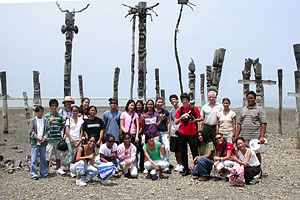 The student group at Saemangeum
The student group at Saemangeum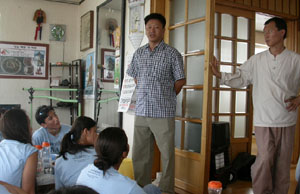 Students with Mr Yeom Jeong-Oo (l.) and Mr Ju Yong-Gi (r.)
Students with Mr Yeom Jeong-Oo (l.) and Mr Ju Yong-Gi (r.)We are also very grateful to one of the students from this trip, Desiree Vea, who has mailed us a copy of her journal entry for the day she visited Saemangeum, which she has given us permission to post: to read her thoughtful and inspiring words please go to A Visit to Saemangeum.
01 June 2005
Saemangeum: Revealed in Black-and-White
www.saemangeumphotos.com 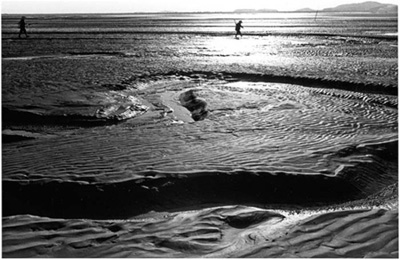
The Saemangeum estuarine system is without doubt one of South Korea's greatest natural assets. Its longterm conservation would symbolise the maturing of South Korean development policy, while its reclamation would lead to massive declines in shorebird populations, and undoubted hardship for many thousands of dependent fisherfolk. Birds Korea has campaigned for the conservation of this area for many years, both with Korea's leading environmental NGOs and with international groups and specialists, working to raise awareness of the enormous value of this estuarine system - not only as a wetland critical to birds but also to people.
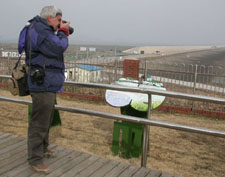
Lacking powerful enough images of the area and its people, however, we were especially delighted to be contacted in 2004 by professional photographer, Dr. Charles Page - who has taken photographs in more than 60 countries over the last 40 years, for both publication and exhibition use. A lecturer at the prestigious Queensland College of Art, Griffith University in Australia, Dr. Page is a passionate believer in the power of photography to capture emotions and stories that for most of the time remain half-hidden. Having learnt of the impacts to (Australian) shorebirds by the Saemangeum reclamation, and having seen the faces of people to be left behind by the reclamation as revealed by BBC World's excellent "Dyke Hard" documentary, Dr. Page determined to visit Korea this spring to capture "the human face" of the Saemangeum tragedy, to "reveal the contrasts between that which is most beautiful and that which is most ugly".
In March (as reported at: www.birdskorea.org/saemhome_apr2005), Dr. Page came to Korea and assisted by Birds Korea and by leading independent local activist Chu Yong-Gi captured series after series of provocative black-and-white images of Saemangeum landscapes and people.
Dr. Page has now put a collection of his extraordinary and lyrical images online: to view them go to www.saemangeumphotos.com. Moreover, for those looking for ways to help fund opposition to the project, please consider ordering prints from the website - an extremely generous thirty percent of all money raised by sales of these images will be donated to Birds Korea by Dr. Charles Page, to help fund our bird and habitat conservation activities.
Saemangeum - an update - 01 April:
With spring comes huge flocks of shorebirds from Australia and New Zealand to the critically important tidal-flats at Saemangeum - what will they find in the years to come? With the seawall still unfinished, and the project challenged by the courts, Birds Korea is supporting a series of international initiatives...want to learn more? The report also carries a link to new, large images which show how the developers intend this vitally-important wetland to look when they've finished with it.
Please go to Saemangeum April 2005
11 February 2005
How the Korean media reported the Saemangeum Ruling The Court Ruling of February 4th was undoubtedly extremely important. What needs to be understood though is that this decision has not been welcomed throughout Korea. The media - as would be expected - has come out with some very different opinions and editorials (though all now recognise that the reclamation is at the very least "controversial"). Some newspapers question the wisdom of the court's decision whilst others welcome it. Some see the decision as resulting from the pressures of "extreme environmentalism", whilst others state that the ruling was an inevitable result of poor Governmental planning. Some urge the government to continue regardless, whilst others worry about the long-term impact on future "national projects".
The fight over the future of the Saemangeum wetlands is extremely complex, and it is certainly not finished yet. The view of Birds Korea is straightforward: we want the project halted before the damage it is causing becomes irreversible, and that's what we will continue to work for, but it must be understood by all of us fighting this reclamation that ours is just one opinion amongst many.
In other words - the court ruling was not a final victory.
"February 4th" was a great win, but there are many more battles ahead...To read how the media has responded go to Korean Media Response.
06 February 2005
Government Appeals Saemangeum Ruling (The Korea Times, Feb-06-2005) The government said Sunday it has decided to appeal the Seoul Administration Court's ruling on Friday to cancel or alter the original plan for the Saemangeum reclamation project, signaling a legal battle that may take several years.
During a media briefing, Lee Myung-soo, vice minister of the Agriculture and Forestry Ministry, which is responsible for the $2.2 billion development venture, said it can take on board opinions from environmental groups, but the project will be carried out as planned.
The court recommended the government reconsider the project, citing the huge cost to maintain water quality in the reclaimed area and its possible environmental and economic threat.
The government is now putting the final touches on the 33-kilometer-long seawall between Kunsan and Puan on the southwestern coast to turn thousands hectares of mudflats into farmland and a freshwater lake.
Environmental groups have said they will file a separate petition soon for suspension of the construction.
04 February 2005
Court Rules in favour of the Saemangeum wetland
Seoul Administration Court rules in favor of environmental concerns (Yeonhap News: February 4th, 2005) On February 4th, 2005, the Seoul Administrative Court ruled in favor of environmental conservation in a legal suit challenging the controversial Saemangeum Reclamation Project brought by environmental groups and local people living around the Saemangeum tidal-flats.
The court ruled that no economic benefits can be expected from the Saemangeum reclamation project because of the anticipated economic losses caused by water pollution in the proposed reclamation reservoir, and by the destruction of the tidal-flat ecosystem.
The court ruled therefore that it is necessary to cancel or change the permit to reclaim the public water area, because the environmental, ecological and economic damage to be expected from the project is huge and irreversible. They listed the following reasons to support their ruling to change or cancel the original permit: the possibility of using land reclaimed through the project for agriculture is very low; it is anticipated that the water quality in the reclamation reservoir will be too poor to use for agriculture; estimates of economic benefits to be derived from converting the existing area to agriculture are flawed; and massive damage will be caused to the tidal-flat ecosystem.
The court added that no decision has yet been made on the end-use of the land to be reclaimed, but reiterated that it cannot be used for agriculture as water in the reclamation reservoir created for that purpose will be too polluted.
The court did not rule against continuing work to reinforce the existing sea-wall, but did rule against construction of any further sea-wall required to close the remaining 2.7 Km stretch that remains open.
The massive and controversial reclamation project along the southwestern coastline of North Jeolla Province has therefore yet again run into another major hurdle due to this ruling.
Earlier, the court had tried to suggest a way forward by recommending that further research be conducted before their final ruling was made. It also recommended that the government should halt the project and set up a committee of experts to review fully the potential environmental and economic consequences of the reclamation. The court also suggested that parliament should legislate a special law to help iron out such issues. Although, environmental groups and local fishermen had welcomed these recommendations, the government and the ruling Uri Party openly rejected them on January 28th.
As the court has now ruled in favor of environmental conservation, the government will bring the case to the Seoul High Court.
(Translated by Ma Yong-Un [KFEM]; edited by Nial Moores [Birds Korea].)
29 January 2005
Government rejects court ruling The South Korean government decided yesterday to disapprove a Seoul Administrative Court decision from a week ago over the Saemangeum land reclamation project.
The court wanted to turn over the tide embankment project to an independent arbitration body.
The government and environmental groups have been in a continuing dispute over whether the project will bring ecological damage to the ocean and the tidal areas.
Saemangeum is a tidal flat along the western coasts of Gimje, Buan and Gunsan in North Jeolla province. In 1991, the government and the North Jeolla government initiated the Saemangeum project to convert tidal flats to farm land by building a reservoir and sea dike at a cost of more than 3 trillion won ($2.5 billion).
A meeting of ruling government officials was held yesterday at the prime minister's official residence in Samcheong-dong. The meeting, which included Prime Minister Lee Hai-chan, Uri Party Chairman Lim Chae-jung and Agriculture Minister Park Hong-soo, ended with the government rejecting the court's recommendation. It will now file an objection with the court.
"We would need another two or three years to just to exam the quality of the water again and discuss who will be part of the new arbitration body," said a government official. "We've lost enough financially."
The Seoul Administrative Court has already announced that it will make an official, legally binding ruling on Feb. 4. The court, however, is expected to rule in favor of the environmental groups, according to analysts. If that happens, the government could appeal to the Supreme Court.
The court previously recommended an independent committee under the National Assembly or the Blue House. It also suggested stopping the project until the new body discusses it; both measures are closer to what environment groups wanted.
Regardless of the court's decision it's expected neither the government nor environment groups will back down. Analysts said the standoff could continue for more than a year.
18 January 2005
A glimmer of light at the end of the tunnel?
The following report has just appeared in the Korea Herald, saying that a Seoul Court has recognised the fact that the reasons for the reclamation have never been properly laid out and that the reclamation shopuld be suspended pending proper environmental research into its impacts. Whilst any decision to FINALLY halt this environmental disaster- in-the-making would be most welcome, this report does stress that the Court decision can be overturned - or even ignored...
Joo Sang-min, Korea Herald, 18 January 2005 (www.koreaherald.co.kr/site/data).
"A controversial massive reclamation project along the southeastern coastline of North Jeolla Province encountered another problem yesterday when a court recommended further research before it makes a final ruling.
The Seoul Administrative Court said the final decision on the Saemangeum controversy could be available after a special committee of government officials and civilian experts specify the project's purpose and conduct environmental research.
The court has been reviewing the petition submitted by environmental groups in 2001 to terminate the mammoth project as they argue the project will wreak havoc on the local landscape and sea life.
"Any governments, including the incumbent one, have never drawn up the concrete purposes of the project," said presiding judge Kang Young-ho.
The purpose of the project, originally designed to turn tidal land into farmland, has varied to include industrial and tour complexes, company towns and even golf courses.
The court also raised the potentially threatened water quality and government measures aimed at protecting sea life. The court suggested parliament legislate a special law to iron out such issues.
If the advisory decision is accepted by both the petitioners and the government, the ongoing construction of a sea dike will be suspended until after the environmental research result.
The project, which began in 1991, is designed to convert about 120 million pyeong of mud flats into farmland and a reservoir by building a 33-kilometer seawall off the coast. One pyeong is equal to 3.3 square meters. The construction of the 33-kilometer sea dike is about 92 percent complete. About two trillion won has been poured into the project.
The environmental groups indicated they will follow the court's guidelines, saying they will review the recommendation in an open manner.
The Agriculture Ministry responsible for the project said in a statement that it will study the recommendation and decide later on the future course of action.
The advisory decision is not legally binding. If either side protests the court recommendation by Feb. 2, the final court ruling is slated for Feb. 4.
But the controversy is not expected to abate, as either side could appeal to a higher court."



